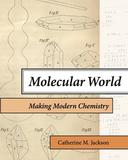Dr Catherine M Jackson
Chemist, historian, and educator, Catherine M Jackson has a passion for using history to understand chemistry’s present and future, as well as its past.
Jackson’s work revises our understanding of nineteenth-century chemistry. Built around practice-based breakthroughs including chemistry’s glassware revolution and turn to synthesis, her forthcoming book Molecular World: Making Modern Chemistry (MIT Press, July 2023) explains a critical period in chemistry's quest to know and manipulate organic nature. A sequel volume Molecular Puzzles: Re-thinking the Ring will show how practical utility – rather than theoretical correctness – lay behind the success of Kekulé’s benzene ring.
Research for Molecular World highlighted the importance of glass and glassblowing to the science of chemistry and it led to a collaborative project called Microheterotopias, developed with master scientific glassblower Tracy Drier at the University of Wisconsin-Madison. Microheterotopias are other worlds in glass, and they’re vital in chemists’ ability to control and manipulate matter. In October 2022, Jackson and Drier are plenary speakers at a meeting jointly organized by the American Chemical Society and the American Scientific Glassblowers’ Society.
Jackson’s teaching spans the modern period, with a focus on chemistry and its connected sciences, including pharmacy and pharmacology as well as physics. She is committed to the importance of history of science to students in the humanities and STEM subjects. Jackson teaches historical methodology at undergraduate and postgraduate levels, including a masters option paper on the material culture approach in history of science, medicine, and technology. She currently convenes the Supplementary Subject in History of Science and supervises the history of science option in Part II of the MChem degree for the Department of Chemistry.
Research Interests
- History of modern chemistry
- History of modern sciences
- History of scientific glassblowing
- Scientific pedagogy and collective practice
- Laboratory history and lab studies
- Material culture studies
Featured Publication
In the Media
Science historian Catherine M Jackson discusses the origins of organic synthesis
Teaching
I currently teach:
Masters:
- Methods and Themes in the History of Medicine
- Ideas meet Things: Why materiality matters in the history of science
Undergraduate:




